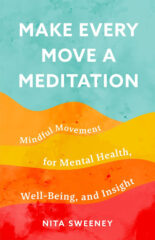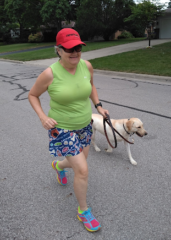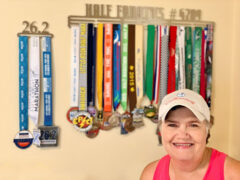 From studying journalism to practicing law to combatting depression by running with her dog, Nita Sweeney has returned to her passion of writing, sharing her life discoveries for herself and others.
From studying journalism to practicing law to combatting depression by running with her dog, Nita Sweeney has returned to her passion of writing, sharing her life discoveries for herself and others.
In this interview, Nita Sweeney talks to us about her newest book Make Every Move a Meditation, now available for preorder, and her trajectory and perspective as a writer.
To begin, how were you first introduced to the practice of meditation?
Nita Sweeney (NS): This is my favorite story. It starts with, “There was this guy.”
In my early thirties I began to date a man who meditated. I really liked him. One day, he asked, “Wanna sit?” I replied, “Wanna what?” He was talking about meditation. I agreed, and he set the microwave timer for five minutes. His primary instruction was “Try not to fidget.” But I couldn’t not fidget.
That was thirty years ago. That man and I will soon have been married 29 years.
Could you talk to us about your newest book, Make Every Move a Meditation? Is it primarily targeted towards someone new to meditation or do you believe someone already familiar with the practice could enjoy it too?

Make Every Move a Meditation
NS: I hope Make Every Move a Meditation will appeal to both audiences.
While I give specific, detailed instructions a beginner can follow, some of the techniques might be unfamiliar to people who have practiced before. Most meditation instruction suggests sitting or walking practice. Although movement meditation is not new, it is also not commonly taught.
There is an assumption that you must sit still in order to develop the calm and concentration necessary for effective meditation practice. I agree that a still body can create conditions to help the mind calm on its own. However, stillness is not necessary. Plus, I suggest doing both sitting and moving practice.
Before you practiced meditation, what were your initial thoughts on the practice? Did it match your expectations or was it completely different than you had imagined?
NS: I’d heard about various types of meditation and I thought they were exotic and odd. But as I continued to practice alongside that guy, because I liked him, I eventually experienced the calm and concentration that comes from meditation practice.
That made me want to continue regardless of him. As it turned out, he continued too, so we have a fine partnership.
What led you to writing about mental health and practicing meditation?
NS: I write about mental health and meditation based on my own experience because putting words on a page is a way to digest what happens to me. It helps me understand life at a deeper level.
I’ve been writing for many years and when I was looking for a book project that would sell, my journey of using running to treat my mental health symptoms occurred to me as a marketable and interesting idea. Apparently, it was.
I’d also been writing about meditation for many years in the hope of creating an accessible instruction book. I meditate while I run and that improves my mental health. That combination resulted in another book.
What lessons did you learn from writing Depression Hates a Moving Target? How is Make Every Move a Meditation different?
NS: Depression Hates a Moving Target taught me how difficult it is to capture the experience of mental illness. I did my best. People who have been there get it. Those are my target readers—people who have touched the darkness. I’m always happy / sad when someone who reads that book says they feel like I’m in their mind.
 That first book is a running and mental health memoir. It can be used as a training manual, and many people use it that way, but it is more about my inner experience of being someone who lives with bipolar disorder and how some days just getting up is a victory.
That first book is a running and mental health memoir. It can be used as a training manual, and many people use it that way, but it is more about my inner experience of being someone who lives with bipolar disorder and how some days just getting up is a victory.
Make Every Move a Meditation also includes examples from my life, but they are purely instructive. I wrote it intending to instruct readers how to meditate while they move. I began the book by explaining why someone might bother meditating at all, and especially why someone might bother meditating while they’re exercising. Don’t we already have enough to do? I do my best to convince the reader it is worth the effort. And then, step-by-step, I show them how it’s done.
Does meditation ever help inspire new writing ideas to you? Conversely, do you find writing to be a meditative experience?
NS: Yes and yes! Although I choose an object of meditation during any meditative interval, thoughts naturally arise. Sometimes those include ideas about a writing project. The idea for what I hope to be my next book, a daily meditation practice guide for living in the moment, came to me nearly 30 years ago during a brief period of meditation in a recovery meeting. During practice, when my mind calms down, those “ah ha” moments happen all the time.
The angst-ridden journals I scrawled as a teenager may have also counted as meditative writing because they brought me back to the moment. And, I always felt better after. I was less angry, more calm, and able to make better decisions.
Later, I found Natalie Goldberg’s book, Writing Down the Bones. Once I began doing her Zen-based writing practice method, I saw the connection, the overlap between writing and meditation.
What writing advice do you have for those struggling to put their pen to the paper?
NS: Try something. Anything. Set a timer and go for 10 minutes without stopping. If you can’t do that, set a timer and go for 10 minutes and write an outline about what you want to write.
There is no one way to do it. Each of our brains is different. I can tell you what works for me. You can go try that and fail miserably. You have to find your own way and once you find it you have to trust it. And that might work for one project or two projects and then it might stop working. The next project might require a different way.
Also, read a lot. Read in the genre you want to write in. Let it wash over you, flow through you. You will absorb it unconsciously. But the thinking types will want to study it as if that author was a mentor. Pick it apart. See how they’re doing it. Be an apprentice. And let that inspire you. But remember when you read a book, it has been edited over and over and over. You are not reading someone’s first drafts.
Coming from a journalism and law background, were you always able to envision having a career as a writer? What is an unexpected challenge that comes with being a writer?
NS: When I was young, I told my father I wanted to be a writer. He responded that writing was an excellent skill which would serve me in whatever profession I chose. I didn’t know any writers and the message I heard, whether intended or not, was that writing was not an acceptable profession. I knew I wanted to write, but I didn’t know what that looked like.
I tend to be a practical person, so instead of studying English or creative writing, I chose journalism. That seemed like a better way to earn a living. Because I was smart and could write, the college counselor directed me toward law school. I was able to stay in the practice of law as long as I did because I could research and write well. But in the firm where I worked, promotion required trial work and client development. That was not my skill set. Eventually, I found my way back to journalism, writing magazine feature articles. And ultimately, I wound up doing what I really wanted: writing books.
What have you been reading lately?
NS: I just finished A Mindful Nation by Congressman Tim Ryan, who is running for Senate in Ohio where I live. His well-written book offers a variety of uses for mindfulness meditation practice including basic instructions for environments such as schools, health care settings, and the military. I really enjoyed it.
 Do you have any other topics or genres you’d like to write about next?
Do you have any other topics or genres you’d like to write about next?
NS: There’s always that unfinished novel about the unicorn barista who unknowingly joins a troop of homeless forest people trying to save some ancient trees.
I’d also like to finish the early drafts of different memoirs about my relationship with various family members. And poetry beckons. I want to write it all.
Nita Sweeney is the award-winning wellness author of the running and mental health memoir, Depression Hates a Moving Target: How Running with My Dog Brought Me Back from the Brink and co-creator of the writing journal, You Should Be Writing: A Journal of Inspiration & Instruction to Keep Your Pen Moving. Her upcoming book, Make Every Move a Meditation was featured in the Wall Street Journal. Nita lives in central Ohio with her husband, Ed, and their yellow Labrador retriever, Scarlet. Download your free copy of Nita’s eBook Three Tools for a Happier, Healthier Mind.

Congratulations, Nita, on your second book!! Looks wonderful. I’m still messing with my first one!! Blessings,